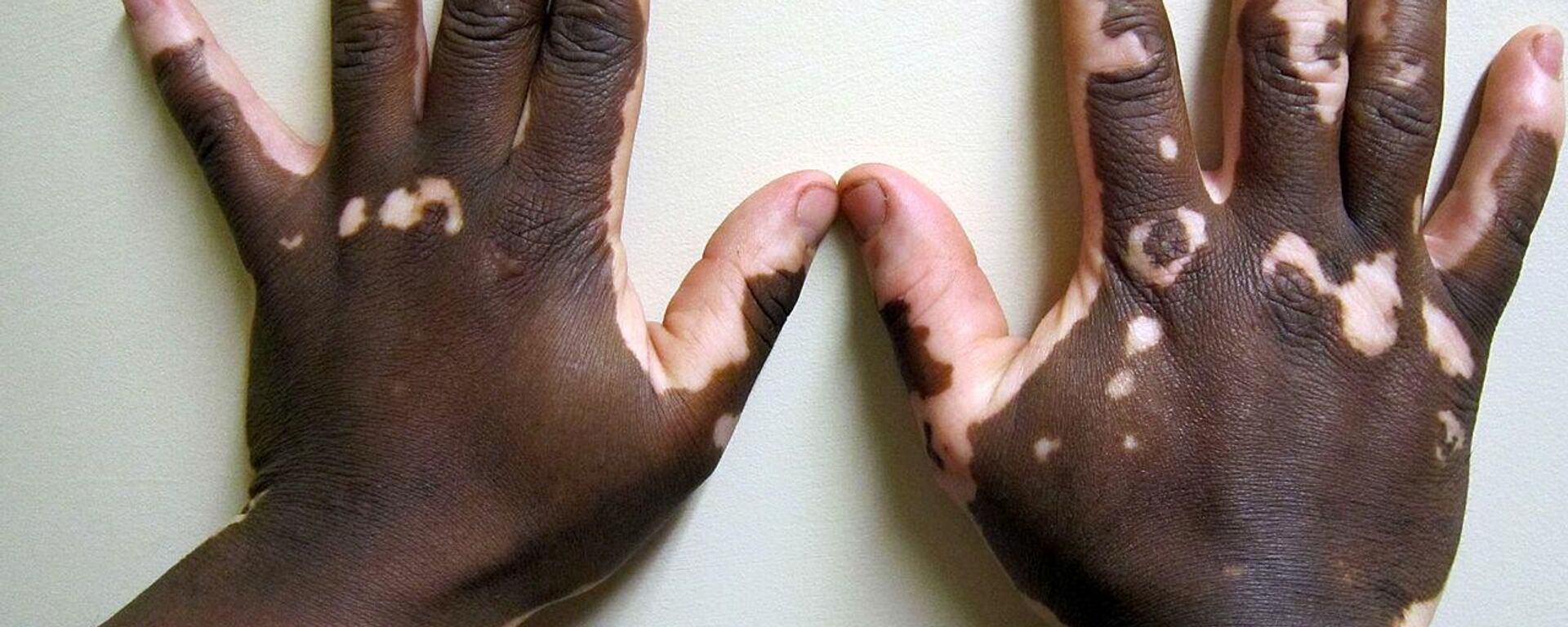https://sputniknews.in/20230213/what-is-sickle-cell-disease-that-india-wants-to-eliminate-by-2047-859170.html
What is Sickle Cell Disease That India Wants to Eliminate by 2047?
What is Sickle Cell Disease That India Wants to Eliminate by 2047?
Sputnik India
India plans to eliminate the dangerous sickle cell anemia by 2047 — the year when the nation will mark 100 years of independence from British colonizers.
2023-02-13T17:31+0530
2023-02-13T17:31+0530
2023-02-13T17:31+0530
sickle cell anaemia
india
sickle cell disease
indian tribes
health
union budget
https://cdn1.img.sputniknews.in/img/07e7/02/0d/860180_167:0:1234:600_1920x0_80_0_0_695ce32fbf41e1fb75ad357abae6caf6.jpg
The Indian government recently announced its ambition to eliminate the dangerous sickle cell anemia by 2047 — the same year as the nation marks 100 years of independence from the British colonizers."A mission to eliminate sickle cell anemia by 2047 will be launched. It will entail awareness creation, universal screening of seven crore (70 million) people in the age group of 0-40 years in affected tribal areas and counseling through collaborative efforts of central ministries and state governments," Indian Finance Minister Nirmala Sitharaman said as she was presenting the Union Budget 2023 on February 1.Sputnik spoke with experts to understand in detail how dangerous sickle cell anemia is and how the Indian government is going to fight the disease.What is Sickle Cell Disease?In a conversation with Sputnik, Dr. Aniket Mule, consultant internal medicine, Wockhardt Hospitals, Mumbai, explained that Sickle Cell Disease (SCD) is an "inherited group of blood disorders, usually transferred from the parents to the child usually during birth."In other words, sickle cell anemia is a shortage of RBCs. Generally, RBCs are round in shape. However, if an individual has SCD, their RBCs become C-shaped, like a sickle, as well as sticky and hard to move, which eventually shortens the life of human blood cells from 120 days to 10-20 days.Why is Sickle Cell Disease Widespread Among Tribal Indians?The disease is now majorly in the tribal or rural population of 17 Indian states - Gujarat, Maharashtra, Rajasthan, Madhya Pradesh, Jharkhand, Chhattisgarh, West Bengal, Odisha, Tamil Nadu, Telangana, Andhra Pradesh, Karnataka, Assam, Uttar Pradesh, Kerala, Bihar, and Uttarakhand.As per Indian government data, about 1 in 86 births among the Scheduled Tribes is affected by the disease."No one knows when the mutation arose. However, it most likely arose in Africa and spread to India due to population migration. As the people marry within a given tribe, the mutation tends to be more prevalent in tribes," he stated.Can India Eliminate Sickle Cell Disease by 2047?Most experts have welcomed the government's announcement to launch a massive campaign against the disease. However, they said the government needs to disclose how it plans to eliminate it, as it has already missed deadlines to eradicate similar illnesses, such as Kala Azar (Visceral leishmaniasis), the 2020 deadline for which has been pushed up to 2023. Filariasis' new deadline is now also 2030, rather than 2017.Meanwhile, experts also remarked that having a dedicated mission for the neglected population is always welcome. Calling it a "Herculean task," Dr. Reddy said that the government needs to set up systematic population screening and mandated screening of all newborns in high-prevalence zones."Community counseling about the disease, its genetic Inheritance, and marriage counseling will reduce the incidence of the disease. Both partners with the trait will have a 50% chance of their children being born with a homozygous state leading to sickle cell disease. In addition, disruptive genetic engineering technologies offer a cure to single-gene mutation-based diseases," Dr. Reddy added.It is believed that currently 20 million Indians have SCD.As of now, the disease can only be treated with bone marrow or stem cell transplantation; however, doctors frequently do not opt for it, as it has many potential complications.
https://sputniknews.in/20230117/doctors-throw-light-on-vitiligo-disease-after-indian-actress-diagnosed-with-skin-disorder-523298.html
india
Sputnik India
feedback.hindi@sputniknews.com
+74956456601
MIA „Rossiya Segodnya“
2023
Deexa Khanduri
https://cdn1.img.sputniknews.in/img/07e6/0c/13/138923_52:0:533:481_100x100_80_0_0_cadf23d341691fc65ff2b22fd1afe584.jpg
Deexa Khanduri
https://cdn1.img.sputniknews.in/img/07e6/0c/13/138923_52:0:533:481_100x100_80_0_0_cadf23d341691fc65ff2b22fd1afe584.jpg
News
en_IN
Sputnik India
feedback.hindi@sputniknews.com
+74956456601
MIA „Rossiya Segodnya“
Sputnik India
feedback.hindi@sputniknews.com
+74956456601
MIA „Rossiya Segodnya“
Deexa Khanduri
https://cdn1.img.sputniknews.in/img/07e6/0c/13/138923_52:0:533:481_100x100_80_0_0_cadf23d341691fc65ff2b22fd1afe584.jpg
is there a cure for sickle cell anemia, sickle cell anemia and malaria, sickle cell anemia life expectancy, what type of mutation causes sickle cell anemia, how is sickle cell anemia inherited, what type of mutation is sickle cell anemia, india fight against sickle cell disease, what is sickke cell disease, how dangerous is sickle cell disease
is there a cure for sickle cell anemia, sickle cell anemia and malaria, sickle cell anemia life expectancy, what type of mutation causes sickle cell anemia, how is sickle cell anemia inherited, what type of mutation is sickle cell anemia, india fight against sickle cell disease, what is sickke cell disease, how dangerous is sickle cell disease
What is Sickle Cell Disease That India Wants to Eliminate by 2047?
Deexa Khanduri
Sputnik correspondent
Life-threatening sickle cell anemia (SCA) usually appears at an extremely young age — about six months in a baby.
The Indian government recently announced its ambition to eliminate the dangerous sickle cell anemia by 2047 — the same year as the nation marks 100 years of independence from the British colonizers.
"A mission to eliminate sickle cell anemia by 2047 will be launched. It will entail awareness creation, universal screening of seven crore (70 million) people in the age group of 0-40 years in affected tribal areas and counseling through collaborative efforts of central ministries and state governments," Indian Finance Minister Nirmala Sitharaman said as she was presenting the Union Budget 2023 on February 1.
Sputnik spoke with experts to understand in detail how dangerous sickle cell anemia is and how the Indian government is going to fight the disease.
What is Sickle Cell Disease?
In a conversation with Sputnik, Dr. Aniket Mule, consultant internal medicine, Wockhardt Hospitals, Mumbai, explained that Sickle Cell Disease (SCD) is an "inherited group of blood disorders, usually transferred from the parents to the child usually during birth."
"The sickle cells die prematurely, resulting in a chronic lack of red blood cells (RBC). As they pass through small blood arteries, sickle cells become caught and obstruct the blood flow, which can cause dangerous consequences (health issues) such as infection, acute chest syndrome, and stroke." Dr. Mule.
In other words, sickle cell anemia is a shortage of RBCs.
Generally, RBCs are round in shape. However, if an individual has SCD, their RBCs become C-shaped, like a sickle, as well as sticky and hard to move, which eventually shortens the life of human blood cells from 120 days to 10-20 days.
Why is Sickle Cell Disease Widespread Among Tribal Indians?
The disease is now majorly in the tribal or rural population of 17 Indian states - Gujarat, Maharashtra, Rajasthan, Madhya Pradesh, Jharkhand, Chhattisgarh, West Bengal, Odisha, Tamil Nadu, Telangana, Andhra Pradesh, Karnataka, Assam, Uttar Pradesh, Kerala, Bihar, and Uttarakhand.
As per Indian government data, about 1 in 86 births among the Scheduled Tribes is affected by the disease.
According to Dr. Krishna Reddy Nallamalla, regional director of South Asia ACCESS Health International, inheritance of single nucleotide/ gene mutations is common when people breed within closed communities.
"No one knows when the mutation arose. However, it most likely arose in Africa and spread to India due to population migration. As the people marry within a given tribe, the mutation tends to be more prevalent in tribes," he stated.
Can India Eliminate Sickle Cell Disease by 2047?
Most experts have welcomed the government's announcement to launch a massive campaign against the disease. However, they said the government needs to disclose how it plans to eliminate it, as it has already missed deadlines to eradicate similar illnesses, such as Kala Azar (Visceral leishmaniasis), the 2020 deadline for which has been pushed up to 2023. Filariasis' new deadline is now also 2030, rather than 2017.
Meanwhile, experts also remarked that having a dedicated mission for the neglected population is always welcome.
"Having a mission goal is not wrong, especially if it involves the most neglected populations. Sincere policy efforts in that direction are more important than achieving the goal itself. Few countries have demonstrated that it is possible," Dr. Reddy said.
Calling it a "Herculean task," Dr. Reddy said that the government needs to set up systematic population screening and mandated screening of all newborns in high-prevalence zones.
"Community counseling about the disease, its genetic Inheritance, and marriage counseling will reduce the incidence of the disease. Both partners with the trait will have a 50% chance of their children being born with a homozygous state leading to sickle cell disease. In addition, disruptive genetic engineering technologies offer a cure to single-gene mutation-based diseases," Dr. Reddy added.
It is believed that currently 20 million Indians have SCD.
As of now, the disease can only be treated with bone marrow or stem cell transplantation; however, doctors frequently do not opt for it, as it has many potential complications.



